We’ve poured countless hours into building, refining, and improving our mattress testing and scoring system. Our system is designed to create a clear and fair quantitative assessment for mattresses.
Using our scores as a guideline you can quickly and easily identify the mattresses that are best for you.
Below we’re going factor-by-factor so you can see exactly how we test and score mattresses.
Scoring Factors
Our overall score is based on a weighted average of 8 scoring factors.
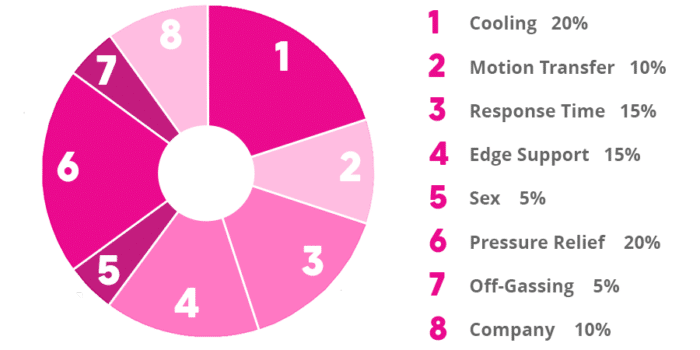
Each factor is given a weight based on the level of importance, which we combine together to determine the total score. Our individual factors are rounded up to one decimal place. Our overall mattress scores are rounded up to the second decimal place.
In addition, we also test and analyze both sinkage and bounce. The objective measurements for sinkage and bounce are rounded up to two decimal places. These were scoring factors within our 1.0 scoring system.
WinkBed Luxury Firm Sinkage
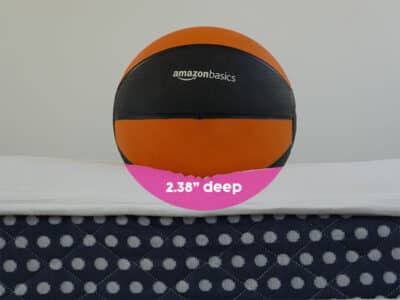
WinkBed Soft Sinkage
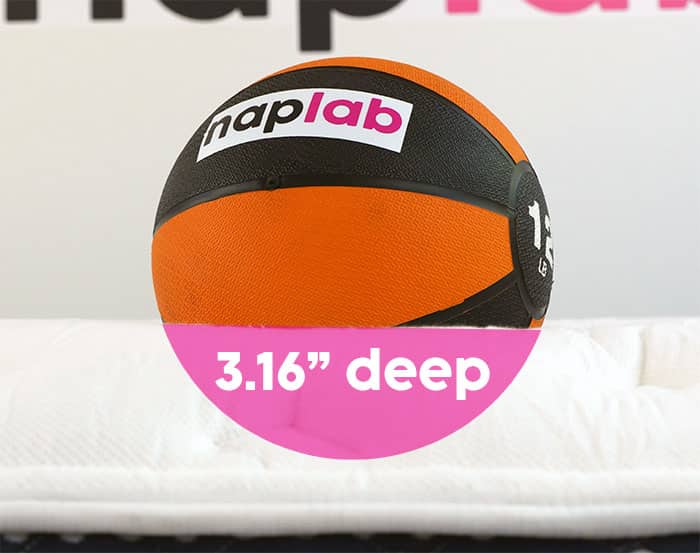
While we think they are relevant and important to test and discuss, we made the decision to remove them as scoring factors for our 1.1 scoring system (which is our current scoring system), given their highly preferential nature.
Understanding Our Scores
We use a 1-10 point grading scale. The more points a mattress scores in any given criteria, the better its performance is going to be.
- 10 – this is an exceptional score, it just doesn’t get much better than this
- 9.5-9.9 – this is an excellent score, most sleepers will be thrilled with the performance level
- 9.0-9.4 – this a very good score, while there is room for improvement, it’s still a very good performer
- 8.5-8.9 – this is a good score, while it’s not perfect, it’s still likely to be good enough for many sleepers
- 8.0-8.4 – this is a fair score, depending on the factor and your desires this could be a red flag on a mattress to avoid
- 7.5-7.9 – this is a poor score, there are significant issues
- 7.0-7.4 – this is a very poor score, there are significant issues
- <7.0 – this a failing score, there are significant issues
Scoring Methodology
Over time, we may find ways to improve our testing process, adjust scoring criteria, add / remove / revise scoring factors, and make other changes. These adjustments are designed to help ensure our scores create the most accurate and helpful mattress recommendations.
Our current scoring methodology is version 1.1.
If / when we update our scoring methodology we may also update mattress reviews at that time. At the top of all mattress review pages you’ll find the current scoring methodology which that mattress was tested under.
You can find information on our legacy scoring systems below:
- Scoring system 1.0 – August 2021 to September 2021
Cooling
Our cooling score is a subjective assessment based on:
- Material construction
- Mattress design
- Sinkage depth
- Objective data from our cooling test
- Subjective experience during our cooling test
Whether or not a mattress sleeps cool is highly subjective, as there are numerous factors that impact cooling performance. Our cooling score looks at the overall cooling picture and we provide a score based on that overall view.
Below are the specifics we’re looking at when making our assessment.
Material Construction
What is the mattress made out of? Is it using traditional heat reactive memory foam or a more modern foam formulation? Does the foam have additives that could improve cooling like gel or copper?
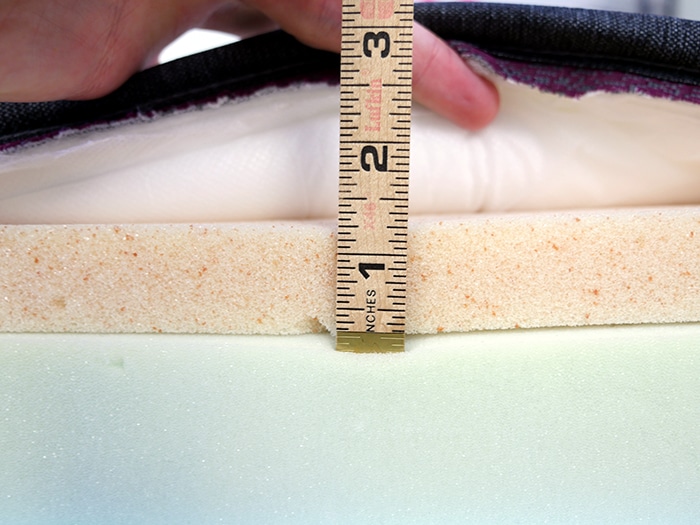
Is a cooler foam like latex or a latex-like poly foam used as opposed to memory foam? How thick are the comfort layers and how close are those to the sleeper’s body?
The specific materials used within the mattress make a significant impact on how cool the mattress will be.
Mattress Design
Is it a memory foam mattress? Combo foam? All foam? Hybrid? Coil-on-Coil? Each mattress design type performs better or worse for cooling.
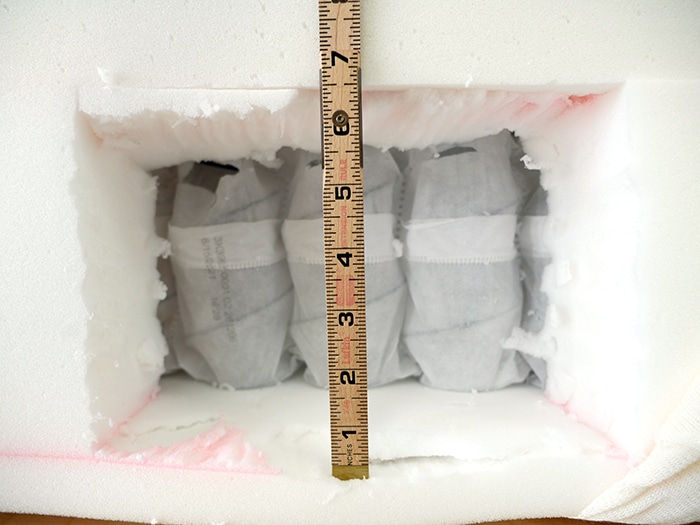
Does the mattress design incorporate elements that enhance breathability, for example, airflow channels cut within the foams? Aeration holes within the foam? Placing memory foam or other warmer materials further away from sleepers?
The mattress design elements greatly impact cooling performance.
Sinkage Depth
How deep do sleepers sink and how much hug and contour is placed on the body? The deeper you are the more material is physically touching and wrapping around your body, which can exacerbate heating issues.
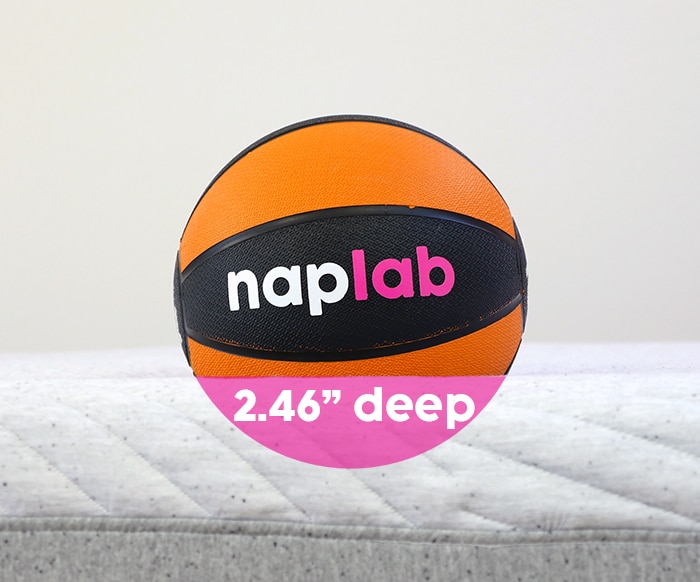
Objective Data
Our cooling test uses a thermal camera to get precise surface level temperatures on the mattress. To complete this test we start by taking a thermal image before anyone lies on the mattress.
Max Temp.
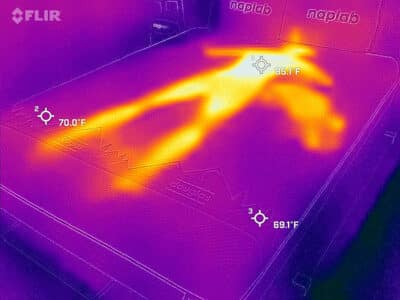
Ending Temp
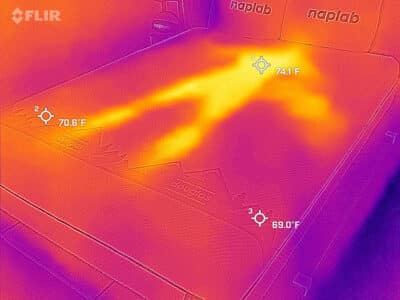
Next, we lie on the mattress for 15 minutes, allowing it to absorb our body heat. Finally, we get up from the mattress and take thermal photos at 6 different time markers (0, 1, 2, 3, 4, and 5 minutes).
We analyze this data to help bring an objective data point into our overall score.
Here’s the scale we use to determine cooling scores:
- 10 – Exceptional cooling performance
- 9.5 – Excellent cooling performance
- 9.0 – Very good cooling performance
- 8.5 – Good cooling performance
- 8.0 – Fair cooling performance
- 7.5 – Poor cooling performance
- 7.0 – Very poor cooling performance
Motion Transfer
Our motion transfer test uses accelerometer data to show motion through an objective, quantitative numbers. To complete our motion transfer tests we place our accelerometer on one side of the mattress and drop a 12 pound medicine ball on the other side.
Acceleration is measured in meters per second squared (m/s2). If an object (in this case our accelerometer) accelerates in 5.0 m/s2 that means the speed is increasing by 5.0 meters every second. The higher the acceleration, the more motion is created on the mattress.
The initial medicine ball drop and rebound creates an acceleration range (IE, a minimum and maximum acceleration), which are the data points we use for our scores.
Here’s the scale we use to determine motion transfer scores:
- 10 – acceleration range ≤ 5 m/s²
- 9.5 – 5 m/s² < acceleration range ≤ 7 m/s²
- 9.0 – 7 m/s² < acceleration range ≤ 9 m/s²
- 8.5 – 9 m/s² < acceleration range ≤ 11 m/s²
- 8.0 – 11 m/s² < acceleration range ≤ 13 m/s²
- 7.5 – 13 m/s² < acceleration range ≤ 15 m/s²
- 7.0 – 15 m/s² < acceleration range ≤ 17 m/s²
Response Time
Mattresses with a faster response time allow for easier movement of sleepers.
Response time is the amount of time it takes for a mattress to release its materials and respond back to its original shape. Memory foam mattresses tend to offer slower response time, which can leave some sleepers feeling stuck.
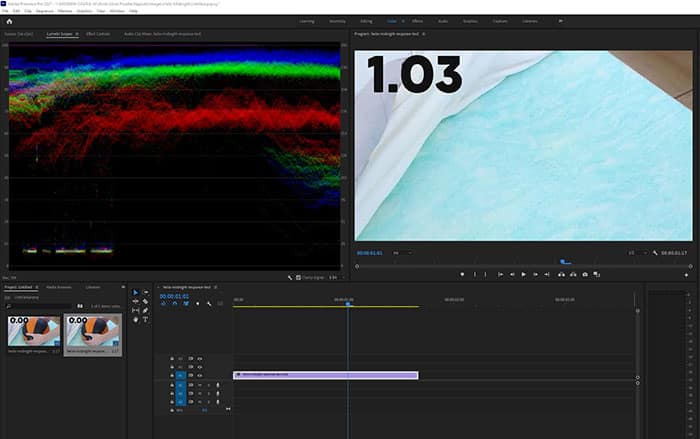
To test response time we place a 12 pound medicine ball on the mattress. Once it’s fully at rest we quickly remove the medicine ball. We record the process using a high FPS camera, overlay a stop watch, and then go frame-by-frame to assess exactly how long the mattress takes to recover.
On many mattresses, they will be mostly recovered fairly quickly, while a complete recovery of all foams can take longer. Mostly recovered to us means about 80%. I say “about” because this is a subjective assessment based on our analysis of the video footage. The mostly recovered stopwatch time is what we use to determine a response time score.
Here’s the scale we use to determine response time scores:
- 10 – response time ≤ 0.4 seconds
- 9.5 – 0.4 seconds < response time ≤ 0.8 seconds
- 9.0 – 0.8 seconds < response time ≤ 1.2 seconds
- 8.5 – 1.2 seconds < response time ≤ 1.6 seconds
- 8.0 – 1.6 seconds < response time ≤ 2.0 seconds
- 7.5 – 2.0 seconds < response time ≤ 2.4 seconds
- 7.0 – 2.4 seconds < response time ≤ 2.8 seconds
Edge Support
Whether you sleep next to, sit near, or have sex on, edge support in a mattress is important. To test edge support we sit directly on the edge of the mattress. Using a yard stick and high resolution photographs, we analyze photos to get a precise measurement of the level of compression on the edge.
Sitting, 140 lbs.

Sitting, 200 lbs.
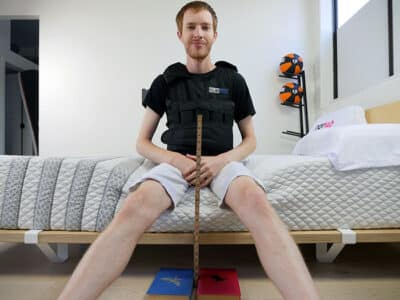
Our edge support score is based on how deep the mattress sinks while sitting directly on the edge of the mattress.
Here’s the scale we use to determine edge support scores:
- 10 – edge sinkage ≤ 3 inches
- 9.5 – 3 inches < edge sinkage ≤ 4 inches
- 9.0 – 4 inches < edge sinkage ≤ 5 inches
- 8.5 – 5 inches < edge sinkage ≤ 6 inches
- 8.0 – 6 inches < edge sinkage ≤ 7 inches
- 7.5 – 7 inches < edge sinkage ≤ 8 inches
- 7.0 – 8 inches < edge sinkage ≤ 9 inches
Sex
In addition to sleep, sex on the mattress is arguably the most important factor where users desire high performance. Certain mattress types may work with or against you when it comes to sex.
Our sex score is a simple equation where we look at 5 different factors. Each factor is given a different weight based on how important we think that factor is for most people.

Our equation inputs for edge support, pressure relief, and cooling are derived from those respective category scores.
As our sex score is based on an equation we have no need for a standardized scale. However, you can still understand the final score in the same ways.
- 10 – Exceptional sex performance
- 9.5 – Excellent sex performance
- 9.0 – Very good sex performance
- 8.5 – Good sex performance
- 8.0 – Fair sex performance
- 7.5 – Poor sex performance
- 7.0 – Very poor sex performance
Noise
Since we don’t specifically look at noise as a larger sub-factor, we are including a supplementary noise scale below. Our rating for noise is a subjective assessment.
Below is our sex noise scale:
- 10 – minimal noise created by the mattress during sex
- 9.0 – moderate noise created by the mattress during sex
- 8.0 – high noise created by the mattress during sex
- 7.0 – very high noise created by the mattress during sex
Sex Bounce
While we do specifically look at bounce as a separate test, the way we analyze bounce for general purpose sleeping doesn’t align well to sex performance. While tons of bounce isn’t always great for sleep, it’s almost always preferable for sex.
As a result, we use the same data from our bounce test, but with scale specific to sex. Our sex bounce scale rewards more points for mattresses that have more bounce.
Below is our sex bounce scale:
- 10 – bounce ≥ 10 inches
- 9.5 – 10 inches > bounce ≥ 8 inches
- 9.0 – 8 inches > bounce ≥ 6 inches
- 8.5 – 6 inches > bounce ≥ 4 inches
- 8.0 – 4 inches > bounce ≥ 2 inches
- 7.5 – 2 inches > bounce ≥ 0 inches
- 7.0 – 0 inches > bounce ≥ -2 inches
Pressure Relief
When you lie on a good mattress you won’t experience any significant pressure points on your body. Mattresses that are too firm or too soft, not thick enough, lacking in comfort materials, sinking too much / too little, and / or using poor quality materials all have the potential to create pressure points.
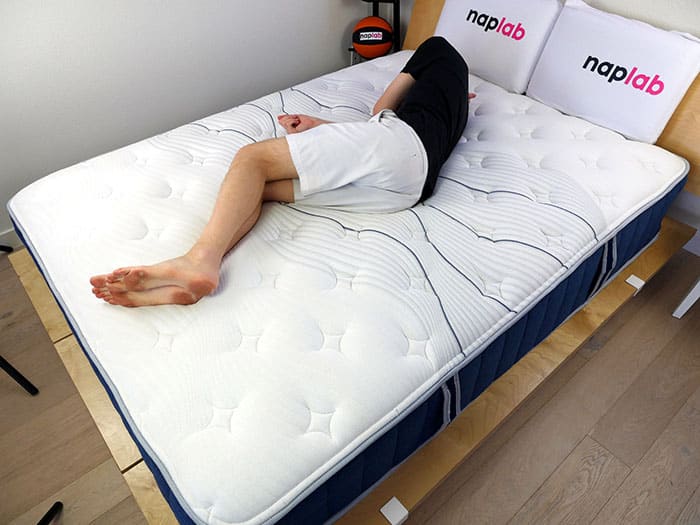
Pressure points are most often created while sleeping your side, as side sleeping creates the greatest pressure on the mattress, and therefore, potentially on your body. Sleepers who have heavier bodies, especially heavier mid-sections, are more likely to experience pressure points.
Objectively measuring pressure relief is impossible, in our view. As a result, we choose to make a subjective assessment of pressure relief based on our experience testing the product, material quality, comfort layer thickness, support layer thickness, and total mattress thickness.
Here’s the scale we use to determine pressure relief scores:
- 10 – Exceptional pressure relief
- 9.5 – Excellent pressure relief
- 9.0 – Very good pressure relief
- 8.5 – Good pressure relief
- 8.0 – Fair pressure relief
- 7.5 – Poor pressure relief
- 7.0 – Very poor pressure relief
Off-Gassing
Off-gassing is the release of a gas that was dissolved or trapped within a material. You can also think of this as the mattress smell. In many cases, foam mattresses have a strong smell when new.
Depending the materials, construction, and other factors, that smell may be gone within a few hours or it may take many months.
Our off-gassing score is a subjective assessment based on the period of time it takes for any strong smell to fully dissipate.
Here’s the scale we use to determine off-gassing scores:
- 10 – off-gassing time ≤ 0 days
- 9.5 – 0 days < off-gassing time ≤ 5 days
- 9.0 – 5 days < off-gassing time ≤ 10 days
- 8.5 – 10 days < off-gassing time ≤ 15 days
- 8.0 – 15 days < off-gassing time ≤ 20 days
- 7.5 – 20 days < off-gassing time ≤ 25 days
- 7.0 – 25 days < off-gassing time ≤ 30 days
Company
Our company score looks at 4 factors that we think reflect the most critical customer service elements.
Factors We Consider
- Trial Period
- Warranty
- Shipping
- Returns
These 4 factors are each worth 25% of the total company score.
Trial Period
How long is the trial period? The longer the trial period the better, as it provides sleepers with more time to make a decision on whether or not that mattress is the right choice.
- 10 – 180+ nights
- 9.0 – 100+ nights
- 8.0 – 30+ nights
- 7.0 – less than 30 nights
Warranty
A longer warranty is typically better than a shorter warranty. However, other factors like pro-rated warranty periods, foam indentation levels, and replacement options dramatically impact how valuable the warranty actually is.
- 10 – 10+ years
- 9.0 – 9 years or less
- 8.0 – 8 years or less
In some cases, mattress warranties have terms that are not in the best interest of consumers. These include prorated periods, aggressive indentation requirements, and less than clear warranty obligations. In the worst of cases, these factors may result in the mattress losing up to 2.0 points from their total warranty score.
In these rare cases, we will explicitly explain why we docked the points within the review page.
Shipping
In our view, the most critical factor for shipping is whether or not it’s free. Paying less for shipping is always better than paying more for shipping.
- 10 – Free shipping
- 9.0 – Minimal shipping costs (less than $100)
- 8.0 – Significant shipping costs (more than $100)
Returns
In our view, the most critical factor for returns is whether or not they are free. Not having to pay for a return / refund is always better than having to pay something.
- 10 – Returns are free
- 9.0 – There is a minimal cost to return (less than $100)
- 8.0 – There is a significant cost to return (more than $100)
Country of Origin
Additionally, we include information on the country of origin where the mattress was manufactured. However, we do not use this as a data point to score.
Some users may find this information helpful, while others may find it irrelevant. We include the data point so you have the information in the event it’s a factor that’s important to you.
Kids Mattress Scoring
To score mattresses for children and kids we use a modified version of our standard scoring system. The modified version drops irrelevant scoring factors, so that we only include factors that could impact the performance of the mattress for children.
Errors & Corrections
Our system of testing and scores is complex, difficult to execute, and difficult to maintain. So there is no question that at times we may execute a test wrong, calculate a score wrong, forget to update a score or analysis, or make other errors.
We make every effort to check and double check our work so that we keep those mistakes to an absolute minimum. But, they will still happen.
If you come across an error, you think or data isn’t right, or see something else that just doesn’t make sense, please let us know here. We will always correct errors and we’re happy to explain anything that needs more clarity.
Suggestions
Do you have a suggestion for how we could make our scoring system better? Please send us your feedback here.



